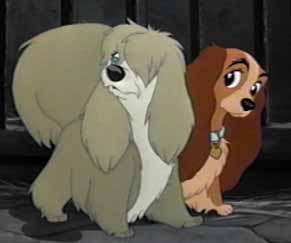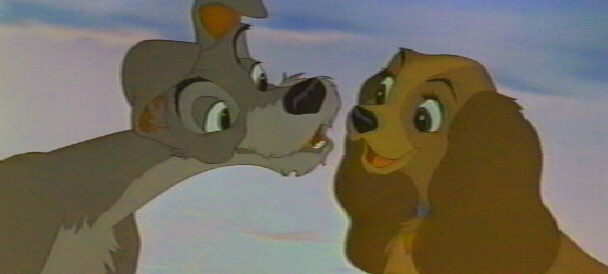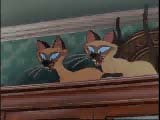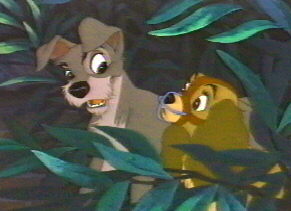
Cast * Interesting Facts * Origins of Lady and the Tramp * Scamp's Adventure: the 2001 sequel

Cast * Interesting Facts * Origins of Lady and the Tramp * Scamp's Adventure: the 2001 sequel
Directed by: Clyde Geronimi & Wilfred Jackson
 Written
by: Ward Greene & Erdman Penner
Written
by: Ward Greene & Erdman Penner
Music by: Peggy Lee & Sonny Burke
Released on: June 22, 1955
Running Time: 75 minutes
Box-Office: $94 million in the U.S.
 Lady...Barbara
Luddy
Lady...Barbara
Luddy
Tramp... Larry Roberts
Darling/Si/Am/Peg... Peggy Lee
Jock/Bull/Dachsie/Joe... Bill
Thompson
Trusty... Bill Baucon
Beaver... Stan Freberg
Aunt Sarah... Verna Felton
Boris... Alan Reed
![]() Barbara Luddy (1908-1979) was not only the voice of Lady in Lady and
the Tramp (1955), but also that of Merryweather in Sleeping
Beauty (1959), Rover in 101 Dalmatians
(1961), Mother Rabbit in Robin Hood (1973),
and
Kanga in the Winnie the Pooh movies (1968 & 1977).
Barbara Luddy (1908-1979) was not only the voice of Lady in Lady and
the Tramp (1955), but also that of Merryweather in Sleeping
Beauty (1959), Rover in 101 Dalmatians
(1961), Mother Rabbit in Robin Hood (1973),
and
Kanga in the Winnie the Pooh movies (1968 & 1977).

![]() There were some
names thrown around before they decided on the ones in the film:
There were some
names thrown around before they decided on the ones in the film:
- Tramp was called Homer, Rags and Bozo
- Si and Am were called Nip and Tuck for a while
- Peg was called Mame at first, but they decided that that would be
an offense to the first lady at the time, Mamie Eisenhower

![]() This
is the first Disney film that was not taken from a published novel or story.
It is also Disney's first animated feature to make use of the Cinemascope
format, and Buena Vista company's first animated feature!
This
is the first Disney film that was not taken from a published novel or story.
It is also Disney's first animated feature to make use of the Cinemascope
format, and Buena Vista company's first animated feature!
![]() The Mellomen (singers at Pirates of the Caribbean) are also the voices
of the Singing Dogs in the "He's a Tramp" song sung -and co-written- by
Peggy Lee. Singing only, though: watch for Boris the Russian Wolfhound
singing the low, low notes (it's Thurl singing); Boris' speaking voice
is Alan Reed (Fred Flintstone!).
The Mellomen (singers at Pirates of the Caribbean) are also the voices
of the Singing Dogs in the "He's a Tramp" song sung -and co-written- by
Peggy Lee. Singing only, though: watch for Boris the Russian Wolfhound
singing the low, low notes (it's Thurl singing); Boris' speaking voice
is Alan Reed (Fred Flintstone!).
 Lady
and the Tramp dated back to 1937, when Walt started work on a story
about a sedate cocker spaniel. Then he read a short story, "Happy Dan,
the whistling dog" by Ward Greene, an editor for King Features, distributor
for the Disney comic strips. Happy Dan was a free soul, a mutt with loyalty
to no man. Walt told Greene, "Your dog and my dog have got to get
together!"
Lady
and the Tramp dated back to 1937, when Walt started work on a story
about a sedate cocker spaniel. Then he read a short story, "Happy Dan,
the whistling dog" by Ward Greene, an editor for King Features, distributor
for the Disney comic strips. Happy Dan was a free soul, a mutt with loyalty
to no man. Walt told Greene, "Your dog and my dog have got to get
together!"
Greene agreed, and in 1943, wrote a story called "Happy Dan, the Whistling
Dog, and Miss Patsy, the Beautiful Spaniel." Walt started developing a
scipt, then dropped the project, reviving it almost a decade later. He
insisted on renaming it Lady and the Tramp, over the opposition
of Greene and RKO salesmen.
SCAMP'S
ADVENTURE: THE 2001 SEQUEL
 |
 |
 |
 |
 |
![]() The February
2001 direct-to-video sequel, Lady & The Tramp II: Scamp's Adventure,
includes the voice talent are Scott Wolf (TV's Party of Five) as
Lady and Tramp's spirited son, Scamp, and former girlfriend Alyssa Milano
(TV's Who's The Boss and Charmed) as Scamp's friend (with
the singing voice of Susan Egan, Hercules'
Meg), the female stray named
The February
2001 direct-to-video sequel, Lady & The Tramp II: Scamp's Adventure,
includes the voice talent are Scott Wolf (TV's Party of Five) as
Lady and Tramp's spirited son, Scamp, and former girlfriend Alyssa Milano
(TV's Who's The Boss and Charmed) as Scamp's friend (with
the singing voice of Susan Egan, Hercules'
Meg), the female stray named  Angel.
Jodi Benson (The Little Mermaid)
is Lady, Jeff Bennett (An Extremely Goofy Movie) voices Tramp, Chazz
Palminteri ("Stuart Little") is Buster, the leader of the strays, Cathy
Moriarty ("Raging Bull") is the flirtatious Ruby, and Mickey Rooney ("The
Black Stallion") is Sparky, the elder statesman of the junkyard.
Angel.
Jodi Benson (The Little Mermaid)
is Lady, Jeff Bennett (An Extremely Goofy Movie) voices Tramp, Chazz
Palminteri ("Stuart Little") is Buster, the leader of the strays, Cathy
Moriarty ("Raging Bull") is the flirtatious Ruby, and Mickey Rooney ("The
Black Stallion") is Sparky, the elder statesman of the junkyard.
The songs of "Lady & the Tramp II: Scamp's Adventure" are written by award winning songwriters Melissa Manchester (The Great Mouse Detective) and Norman Gimbel (1980 Best Song Academy Award winner for Norma Rae's "It Goes Like It Goes").

![]() This new adventure is directed by Darrell Rooney and produced by Jeannine
Roussel, the same team that worked on the The Lion King II: Simba's
Pride, the most successful video premiere in the history of the home
entertainment industry. In Lady & the Tramp II: Scamp's Adventure,
Lady and Tramp have puppies of their own, and live happily under the roof
of their human friends, the Darlings. Lady and Tramp's three daughters,
Annette, Colette and Danielle, love the domesticated life, but Scamp, their
mischievous son, wants nothing better than to see the world outside.
Longing to be wild and free, like his father once was, Scamp takes up with
the Junkyard Dogs, a group of strays who seem to represent the free and
easy lifestyle. When Scamp meets Angel, a lovely female stray, Scamp believes
he's right where he belongs. But Buster, the Junkyard Dogs' leader, is
not about to make it easy on "the house-dog," whom he sees as a rival.
Will Scamp choose an uncertain life on the street, or learn to appreciate
the unconditional love that only a family can give? Taking its cue
from the original "Lady & the Tramp" story, this upcoming sequel is
set in the same early 20th century town as the first film. The returning
cast includes such supporting characters as Jock, the Scottish terrier,
Trusty, the old bloodhound and, of course, Aunt Sarah and her devious Siamese
cats, Si and Am.
This new adventure is directed by Darrell Rooney and produced by Jeannine
Roussel, the same team that worked on the The Lion King II: Simba's
Pride, the most successful video premiere in the history of the home
entertainment industry. In Lady & the Tramp II: Scamp's Adventure,
Lady and Tramp have puppies of their own, and live happily under the roof
of their human friends, the Darlings. Lady and Tramp's three daughters,
Annette, Colette and Danielle, love the domesticated life, but Scamp, their
mischievous son, wants nothing better than to see the world outside.
Longing to be wild and free, like his father once was, Scamp takes up with
the Junkyard Dogs, a group of strays who seem to represent the free and
easy lifestyle. When Scamp meets Angel, a lovely female stray, Scamp believes
he's right where he belongs. But Buster, the Junkyard Dogs' leader, is
not about to make it easy on "the house-dog," whom he sees as a rival.
Will Scamp choose an uncertain life on the street, or learn to appreciate
the unconditional love that only a family can give? Taking its cue
from the original "Lady & the Tramp" story, this upcoming sequel is
set in the same early 20th century town as the first film. The returning
cast includes such supporting characters as Jock, the Scottish terrier,
Trusty, the old bloodhound and, of course, Aunt Sarah and her devious Siamese
cats, Si and Am.

![]() The
Lady & the Tramp II: Scamp's Adventure, the company's first direct-to-video
sequel to one of its classic, pre-'70s features, has taken in a humongous
$50 million in its opening week. More than 3 milllion of the 7 million
videos and DVD copies of the film shipped to retailers were purchased in
the first six days, putting it ahead of first-week sales for last fall's
The
Little Mermaid 2 (2.4 million units), but behind the 1998 video
premiere of The Lion King 2: Simba's Pride
(3.5 million copies sold in its first three days). The $50 million generated
by Tramp II is more than the first-week theatrical opening of ANY
traditionally animated Disney feature.
The
Lady & the Tramp II: Scamp's Adventure, the company's first direct-to-video
sequel to one of its classic, pre-'70s features, has taken in a humongous
$50 million in its opening week. More than 3 milllion of the 7 million
videos and DVD copies of the film shipped to retailers were purchased in
the first six days, putting it ahead of first-week sales for last fall's
The
Little Mermaid 2 (2.4 million units), but behind the 1998 video
premiere of The Lion King 2: Simba's Pride
(3.5 million copies sold in its first three days). The $50 million generated
by Tramp II is more than the first-week theatrical opening of ANY
traditionally animated Disney feature.
![]() Several original
layouts and backgrounds from Lady and the Tramp were retrieved from
the Disney archives to re-create the same look throughout the new film.
The beautiful stained-glass window at the top of Darling's staircase is
the backdrop for Lady's dramatic ascent in the original film and also is
used for a conversation between Lady and Tramp in the new film.
Several original
layouts and backgrounds from Lady and the Tramp were retrieved from
the Disney archives to re-create the same look throughout the new film.
The beautiful stained-glass window at the top of Darling's staircase is
the backdrop for Lady's dramatic ascent in the original film and also is
used for a conversation between Lady and Tramp in the new film.
 |
 |
 |
![]() The horse-drawn
dog pound wagon that was damaged at the end of the original film now sits
atop the junk pile where the Junkyard Dogs live. In Lady and the Tramp
II: Scamp's Adventure, the dogcatcher drives a brand-new, motorized
truck.
The horse-drawn
dog pound wagon that was damaged at the end of the original film now sits
atop the junk pile where the Junkyard Dogs live. In Lady and the Tramp
II: Scamp's Adventure, the dogcatcher drives a brand-new, motorized
truck.
![]() In Lady and
the Tramp II: Scamp's Adventure, the framed Christmas photo that Junior
holds so closely when he's missing Scamp is the very photo that Jim Dear
took of Junior, Lady, Tramp, and their four new puppies at the end of the
first film.
In Lady and
the Tramp II: Scamp's Adventure, the framed Christmas photo that Junior
holds so closely when he's missing Scamp is the very photo that Jim Dear
took of Junior, Lady, Tramp, and their four new puppies at the end of the
first film.
![]() This direct-to-video
sequel generated $110 million in video revenue alone for Disney in 2001,
selling 6.2 million copies of the videocassette ($91.9 million).
This direct-to-video
sequel generated $110 million in video revenue alone for Disney in 2001,
selling 6.2 million copies of the videocassette ($91.9 million).
|
||||||||||||